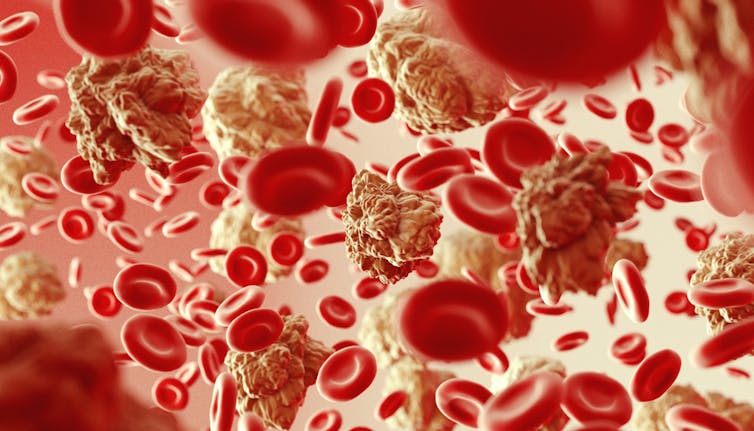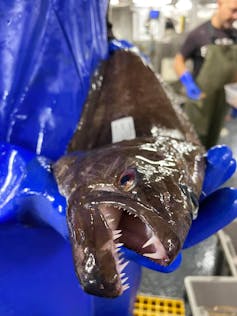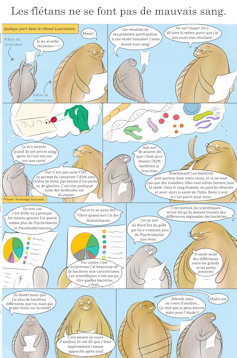
The Gulf of St. Lawrence is an invaluable resource for Canada. Fish and shellfish fisheries that date to the 16th century have remained an essential source of income for many communities, including those on the North Shore and Gaspésie or the Îles-de-la-Madeleine.
For example, in Îles-de-la-Madeleine, nearly 1,800 jobs (for a total of 12,500 inhabitants) were linked to fishing in 2015.
But the industrialization of fishing, and changes in the environment, have brought about many new problems in the management of our fisheries. The abundance of different fish species in the Gulf has fluctuated greatly over the last 20 years.

This article is part of our series, The St. Lawrence River: In depth. Don’t miss new articles on this mythical river of remarkable beauty. Our experts look at its fauna, flora and history, and the issues it faces. This series is brought to you by La Conversation.
A case in point: the number of Greenland halibut has declined drastically. This year, landings are six times lower for fishermen compared to last year.
But other species are benefiting from the situation. This is the case for the population of Atlantic halibut, which is at record levels today.
What is causing these changes? And can we predict further changes?
As a doctoral student in biology at the Institut national de la recherche scientifique (INRS), I am trying to find possible answers to these questions as part of my research work.
A new health monitoring technique
The means available for studying the health of fish at the individual level are limited. On the one hand, we can calculate indicators from the weight and height of individual fish. But these measurements are too vague and don’t tell us much.
The logistics of performing biopsies on the tissue of fish — which requires taking samples from their muscle or organs — are complex. To carry them out, researchers must have to travel to the ocean, physically collect samples and bring them back to a laboratory. And then there are ethical considerations, since obviously fish must be sacrificed to achieve this.
Even so, these methods are not very effective for detecting stress induced by environmental changes, and are not effective for detecting stress at early stages, before the physical effects can become manifest.
Yet in a context where the abundance of certain fish species is in rapid decline, an analysis of their overall health is necessary. Fortunately, a new tool is being developed: the circulating microbiome.

A little-known practice
The circulating microbiome is a biomarker, an alarm signal that can be detected in fish even before their health begins to deteriorate. A good biomarker is sensitive, easy to sample, and inexpensive.
The analysis of the circulating microbiome, made up of the DNA of bacteria found in the blood, is directly inspired by similar analyses performed on humans, which provide a great deal of information.
In particular, these analyses make it possible to detect anomalies resulting from the effect of a stress factor on the body, or the development of a disease.
Changes in the environment can also be detected from studying the circulating microbiome. But a major problem emerges here: a fish is not a human. Humans are studied in such detail that knowledge about their health can then be used for an infinite amount of further research. However, sampling fish blood is not a common practice. So there is a great deal that needs to be done before we can properly evaluate the health of fish.
Since the analysis of the circulating microbiome in fish has never been studied before, a lot of work needs to be done to develop the technique.
Traces of bacteria in the blood?
As blood circulates throughout the body, it comes into contact specifically with bacteria that make up the other microbiomes (intestinal, oral, dermal). Both in fish and humans, these bacteria are essential for good health.
When we analyze bacterial DNA in the blood, it is therefore possible to find bacteria from the intestine, mouth, or skin. But the hypothesis that these are bacteria specific to the blood cannot be completely ruled out either.
While some continue to believe that blood is sterile, and therefore does not contain any bacteria, we have known since the 1970s that this hypothesis is false — it was confirmed in the 2000s by genomic studies. It’s possible that in 1674, the Dutch microbiologist Antonie Van Leeuwenhoek may even have observed bacteria in salmon blood under a microscope.
Today, we can analyze these bacteria in detail by targeting a very specific bacterial gene, the 16S ribosomal RNA gene. Present in all bacteria around the world, this gene varies slightly from one species to another. That makes it possible to identify and analyze the biodiversity of the microbiome.
I eat, therefore I am
Our recent work has made it possible to characterize, for the first time, the circulating microbiomes of turbot and halibut. We have demonstrated that the two fish species have circulating microbiomes dominated by the presence of the species Pseudoalteromonas and Psychrobacter. These bacteria are known to colonize cold environments, for example the bottom of the Gulf of St. Lawrence, which is around 5°C. They are also known to produce bioactive compounds (antibacterials and antifungals). They are more tenacious than other bacteria.

However, differences can be observed between the two species. Turbot has more bacteria called Vibrio, some of which metabolize chitin, a molecule that makes up the shells of the invertebrates on which it feeds. Atlantic halibut, for its part, presents more Acinetobacter bacteria, typical of piscivorous (fish-eating) diets in the intestinal microbiomes. The circulating microbiome in these two fish species therefore seems to be influenced by intestinal bacteria, as is the case in humans. We could therefore potentially link a blood microbiome to the fish’s diet, which is often difficult to estimate.
An embryonic, but promising technique
So this first bacterial mapping of the blood of these two species probably reflects their respective intestinal microbiome. From this characterization, detection of a variation in the composition of bacteria could be linked to stress, a change in the environment or a physiological change in the animal.

For example, we know that in humans, the loss of Actinobacteria in the circulating microbiome is associated with severe acute pancreatitis. And there are dozens of examples like this in humans.
This study, the result of a collaboration between university researchers from INRS, the University of Québec at Rimouski and the Department of Fisheries and Oceans Canada, provides a small overview of the informative potential offered by the blood microbiomes of fish from the Gulf of St. Lawrence.
Further research will make it possible to estimate their health and better predict the evolution of their population. The dramatic collapse of the cod stock in the late 1980s had a major impact on fishermen. Several of them even fear that this situation will happen again with another species. As turbot remains a species at risk, it is essential to ensure better management of St. Lawrence species.
Only by refining our analysis techniques and deepening our scientific knowledge can we prevent this type of collapse from happening again in the future.
Fanny Fronton received a grant from the Fondation Armand Frappier.
This article was originally published on The Conversation. Read the original article.







